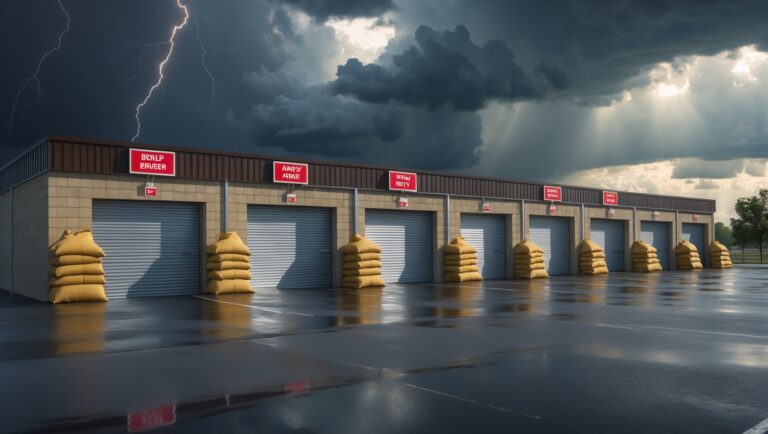Self-Storage Facility Signage: Compliance, Branding, and Customer Experience
Introduction: The Power of Signage in Self-Storage Facilities
Signage is one of the most overlooked yet critical elements of a successful self-storage facility. Whether you operate a small local business or manage a multi-site storage portfolio, the quality and placement of your facility’s signs directly impact compliance, customer experience, and brand reputation. Effective signage does more than just direct traffic or mark unit numbers—it influences first impressions, safety, operational efficiency, and the likelihood that tenants will recommend your storage business to others. In an industry where trust and convenience are paramount, the right signs can mean the difference between a thriving facility and one that struggles with confusion, regulatory fines, or negative reviews. This in-depth guide explores the strategic role of self-storage facility signage, including regulatory considerations, design principles, branding opportunities, and actionable steps for optimizing your signage system.
Why Signage Matters: More Than Just Directions
In the self-storage industry, signage plays three core roles: ensuring legal compliance, supporting your brand identity, and delivering a seamless customer experience. Each of these aspects is essential for operational excellence and business growth.
- Compliance: Local ordinances, accessibility laws, and safety requirements dictate certain signage must be present and visible. Non-compliance can result in fines, lawsuits, or even forced closures.
- Branding: Consistent, attractive signage reinforces your facility’s brand, builds trust, and distinguishes you from competitors.
- Customer Experience: Clear, well-placed signs reduce confusion, minimize staff interruptions, and help tenants navigate your facility efficiently and safely.
Types of Signage Needed in Self-Storage Facilities
Understanding the various signage types required for a self-storage operation is the first step toward compliance and customer satisfaction. Each category serves a unique purpose:
- Entrance and Monument Signs: Identify your facility, attract drive-by traffic, and make a strong first impression.
- Directional and Wayfinding Signs: Guide customers to key areas like office, loading zones, elevators, and unit corridors.
- Unit Numbering and Identification Signs: Mark individual units clearly to prevent confusion and errors during move-in/out.
- Regulatory and Safety Signs: Communicate fire exits, emergency procedures, restricted areas, and ADA compliance.
- Operational Signs: Post office hours, payment policies, access instructions, and facility rules.
- Marketing and Promotional Signs: Advertise specials, referral programs, or new services to attract and retain customers.
Legal and Regulatory Requirements for Storage Facility Signage
Understanding Local Sign Ordinances
Before designing or installing any sign, research your municipality’s sign codes. These regulations often control:
- Sign size, height, and illumination
- Placement distance from property lines or roadways
- Permitted materials and structural requirements
- Prohibited sign types (e.g., flashing or animated signs in residential zones)
Always obtain the necessary permits before installation. Non-compliance can lead to costly violations or forced removal.
ADA Compliance and Accessibility
The Americans with Disabilities Act (ADA) and similar local laws require certain signs to be accessible:
- Braille and Raised Characters: Required for room identification, restrooms, and emergency exits.
- Contrast and Readability: Signs must feature high-contrast colors and legible fonts for those with vision impairments.
- Mounting Heights: ADA guidelines specify the height and location for accessible signs, typically between 48 and 60 inches from the floor.
Fire Safety and Emergency Signage
Fire marshals typically mandate:
- Clearly marked fire exits and escape routes
- Location of fire extinguishers and alarm pull stations
- Maximum occupancy signs in office or common areas
Consult your local fire code and schedule periodic inspections to ensure compliance.
Designing Effective Storage Facility Signage
Clarity and Readability
Effective signage should be instantly understandable—even at a glance from a moving vehicle. Follow these best practices:
- Font Choice: Use sans-serif fonts (like Arial or Helvetica) for maximum readability.
- Font Size: Entrance and directional signs should have large, bold text viewable from a distance.
- Contrast: Choose high-contrast color pairings—dark text on a light background or vice versa.
- Simplicity: Avoid clutter; limit information to essentials and use universally recognized symbols when possible.
Durability and Maintenance
Outdoor signs must withstand weather, sun, and potential vandalism:
- Opt for UV-resistant materials and fade-resistant inks.
- Choose anti-graffiti coatings in urban or high-traffic areas.
- Plan for periodic cleaning and inspections to maintain a professional appearance.
Lighting and Visibility
Illuminated signage is essential for 24/7 facilities or those with evening access:
- Backlit or LED edge-lit signs enhance nighttime visibility.
- Ensure pathway and directional signs are adequately lit after dark for safety and convenience.
- Consider solar-powered lighting for remote or off-grid sign placements.
Consistent Branding
Your facility’s signs should consistently feature your logo, brand colors, and design motifs. Consistency builds trust and fosters recognition across all touchpoints, including:
- Main entry and monument signs
- Office and payment kiosks
- Directional arrows and wayfinding signs
- Vehicle and pedestrian access points
Placement Strategies for Maximum Impact
Entrance and Roadside Visibility
Place your primary monument sign where it is clearly visible to passing traffic and at your driveway entrance. Consider sightlines from all approaching directions and avoid obstructions from landscaping or parked vehicles.
Wayfinding Within the Facility
Strategically position directional signs at every decision point:
- At forks in driveways or hallways
- Near elevators, stairwells, and loading docks
- At the entrance of each building or floor
Use arrows, maps, or color-coded zones for multi-building or large facilities to further aid navigation.
Unit Numbering and Identification
Install clear, sequential unit numbers on or above each door. For large facilities, supplement with building or aisle identifiers to avoid confusion. Use reflective materials for units in low-light areas.
Safety and Regulatory Signage
Mount emergency signs at eye level and close to relevant equipment (e.g., fire extinguishers, exits). Periodically verify that nothing obstructs these signs.
Common Signage Mistakes to Avoid
- Inconsistent Branding: Mismatched colors, fonts, or logos weaken your brand identity and confuse customers.
- Poor Placement: Signs hidden by landscaping, parked vehicles, or other structures fail to serve their purpose.
- Unreadable Fonts or Colors: Fancy scripts or low-contrast color choices make signs hard to read, especially for older customers.
- Non-Compliance: Ignoring local codes, ADA requirements, or safety mandates can result in costly legal troubles.
- Neglected Maintenance: Faded, cracked, or vandalized signs project an image of neglect and can deter potential customers.
Leveraging Signage for Marketing and Customer Engagement
First Impressions and Trust
A clean, well-branded entrance sign signals professionalism and care—qualities storage customers value. Add your phone number, website, or QR code for instant mobile engagement.
Highlighting Promotions and Services
Temporary banners or window decals can advertise move-in specials, referral programs, or unique features (e.g., climate control, 24/7 access). Ensure promotional signs are professionally printed and removed promptly when offers expire.
Self-Service Kiosks and Digital Signs
Touchscreen kiosks and digital displays can provide dynamic information, such as available units, pricing, or security alerts. Ensure digital signs are easy to use and regularly updated.
Community Messaging Boards
Consider a dedicated area for community notices, local events, or facility announcements. This not only engages tenants but also demonstrates your commitment to the neighborhood.
Case Studies: Real-World Signage Successes
Case Study 1: Rebranding Boosts Occupancy
A mid-sized storage operator in the Midwest revamped all facility signage to match new brand guidelines. By updating entrance, directional, and unit signs with consistent colors, fonts, and logos, the facility saw a 12% increase in drive-by inquiries and a 15% rise in occupancy over 18 months. Customer feedback cited the “professional look” as a key reason for choosing the facility over competitors.
Case Study 2: ADA Compliance Avoids Litigation
An urban storage facility faced a potential lawsuit due to lack of Braille and tactile room signs. Proactively updating signage to meet ADA standards not only averted legal action but attracted new tenants seeking accessible storage options.
Case Study 3: Digital Wayfinding Reduces Staff Interruptions
A large multi-building property installed touchscreen wayfinding kiosks at key entry points. The result: a 25% drop in customers seeking staff assistance for navigation, freeing up employees for higher-value tasks and improving tenant satisfaction scores.
Implementing a Signage Audit and Upgrade Plan
Step 1: Conduct a Comprehensive Audit
Walk your entire facility with a checklist. Note missing, damaged, or outdated signs. Photograph problem areas and collect customer or staff feedback on confusing locations.
Step 2: Evaluate Compliance and Branding
Compare each sign against local codes and ADA requirements. Assess whether all signage matches your current brand standards.
Step 3: Prioritize Upgrades
- Safety and legal compliance come first (fire exits, ADA, regulatory notices).
- Next, address visibility and wayfinding issues (directional, unit numbers).
- Finally, enhance marketing and promotional signage as budget allows.
Step 4: Choose Professional Sign Vendors
Select vendors experienced with commercial or self-storage signage. Request references, review material samples, and ensure they can handle permitting and installation if required.
Step 5: Schedule Ongoing Maintenance
Inspect signage quarterly. Clean, repair, or replace as needed—especially after severe weather or vandalism. Keep spare signs for high-risk areas.
Conclusion: Invest in Signage for Sustainable Storage Success
Signage is more than just a functional requirement—it’s an extension of your brand, a pillar of safety, and a critical component of the customer journey in self-storage. By investing in clear, compliant, and attractive signage, you set your facility apart from competitors who overlook these details. The right signs foster trust, reduce operational headaches, and create a seamless experience that tenants will appreciate—and remember when recommending your business to others.
As self-storage markets become more competitive and customer expectations rise, facility owners can no longer afford to treat signage as an afterthought. Take the time to audit your current system, consult regulatory requirements, and work with professionals to design and implement a signage plan that supports your business goals. From the moment a prospective tenant drives by to the day a long-term customer refers a friend, every sign on your property should reinforce the values and professionalism of your storage operation.
Ultimately, high-quality signage is a sustainable investment—one that pays dividends through increased occupancy, better safety records, and improved customer satisfaction. Start with compliance and clarity, build consistency through branding, and don’t hesitate to leverage signage for marketing and engagement. Your facility’s future may well hang on the signs you choose to display today.






